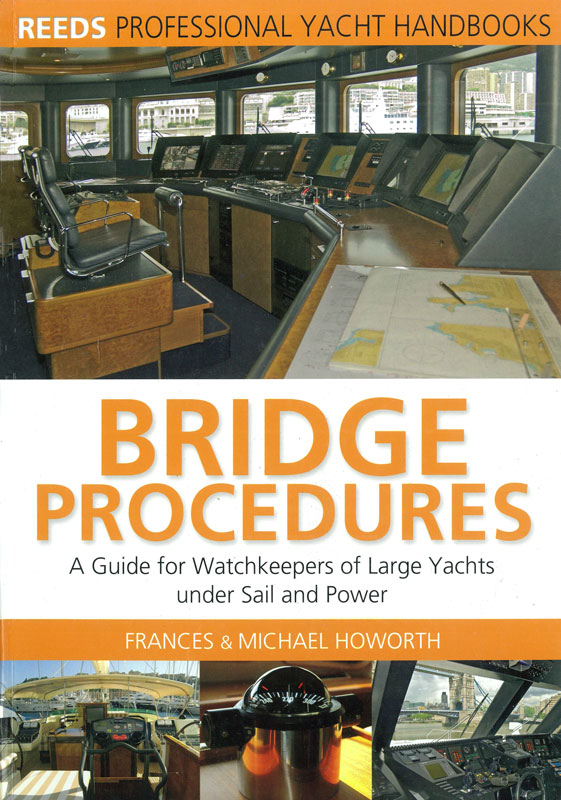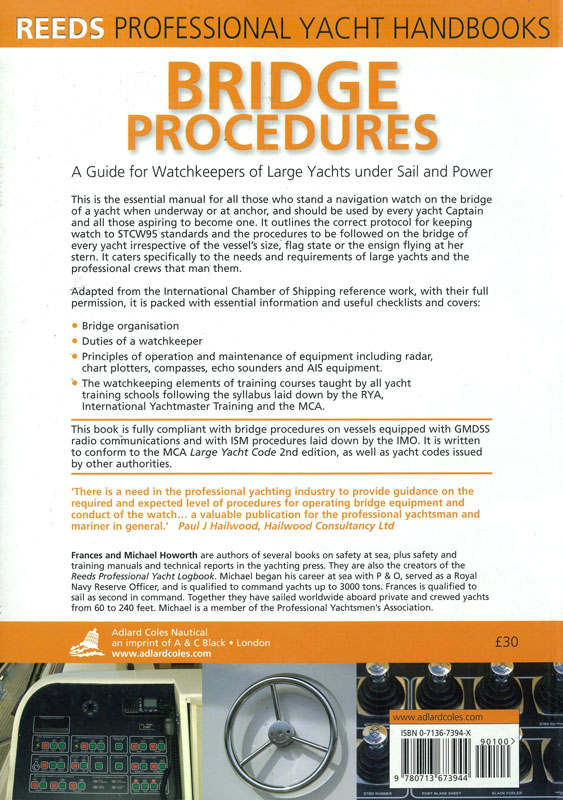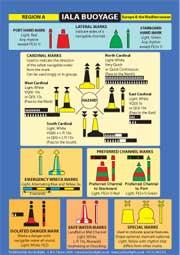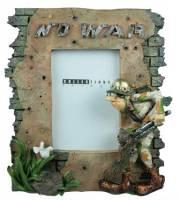Bridge procedures. A guide for wothkeepers of large yahts under sail and power. Процедуры мостика. Руководство для владельцев больших яхт под парусами и мотором
См. также Bridge Procedure Guide. Руководство по процедурам на мостике (5-е издание)
Книга на английском языке.
This guide has been written specifically for yachts over 24 metres, but much of what has been included here applies to every yacht. All bridge watchkeepers should read this book and then, if necessary, seek clarification from their Captain over any points that remain unclear in relation to their particular vessel.
Safe navigation is the most fundamental attribute of good seamanship, and an increasingly sophisticated range of navigational aids today complement navigating officers' basic skills, which of course have accumulated over the centuries.
Sophistication, however, brings its own dangers and the need for precautionary measures to be taken against undue reliance on technology. Experience shows that properly formulated bridge procedures and the development of bridge teamwork are critical to maintaining a safe navigational watch.
Содержание
New crew and familiarisation
Avoiding fatigue
Alcohol and sailing
Use of English by the watchkeeper
Captain's standing orders and the bridge order book
3 The Duties of the Watchkeeper
Captain's representative
Primary duties of the watchkeeper
Controlling the speed and direction of the yacht
Pollution prevention, reporting and emergency situations
Bridge attendance and maintaining a lookout
General surveillance
Lights, shapes and sound signals
Avoiding collisions
Recording bridge activities
Periodic checks on equipment
Checking orders
Changing over the watch
Calling the Captain
Additional duties
4 General Principles of Navigation Practice
Deviating from or leaving the passage plan
Monitoring the progress of the yacht
Voyage data recorders
Plotting positions from electronic position-fixing systems
Navigation in coastal or restricted waters
Watchkeeping in restricted visibility
5 Passage Planning: Establishing Safe Routeing
Overview
Responsibility for passage planning
Charts and publications
The route plan
Notes on passage planning in ocean waters
Notes on passage planning in coastal or restricted waters
Position monitoring techniques
Pre-arrival planning
Passage planning and ships' routeing
Passage planning and yacht reporting systems
Passage planning and vessel traffic services
6 The Need for a Pilot on Board
Pre-arrival information exchange with the pilot
Pilot on board
Navigation responsibilities with a pilot aboard
Captain/pilot information exchange on boarding
The bridge team and the pilot
Monitoring the pilotage
7 Duties of the Watchkeeper at Anchor
8 Controlling the Speed & Direction under Power
Use of the engines
Safe speed (both power and sail)
Control, and different engine types
Steering control under power
Manoeuvring data
Wash waves from high-speed craft
9 Controlling the Speed & Direction under Sail
Use of sails
Steering control under sail
10 Reporting Pollution & Accidents
Pollution reporting obligations
Reporting accidents
11 Action to Take in Emergency Situations
Reporting o Search and rescue o Piracy
12 Operation & Maintenance of the Bridge General
Bridge visits by guests
Bridge tidiness
Closed circuit television
13 Good Radar Practice on J Board
Range scales
Radar plotting
Radar and navigation
Parallel indexing
Heading and speed inputs
Semi-automatic target acquisition
14 Steering Gear & the Automatic Pilot
Testing of steering gear
Forms of steering control
15 Compass Systems on the
Bridge
Magnetic compass
Gyro compass
Compass errors
16 Speed, Distance & Depth
Types of speed measurement
Recording of distance travelled
Echo sounders
17 Electronic Position-Fixing / Systems
Global navigation satellite system
GPS and DGPS
Chart datum and accuracy
18 Charts & Nautical Publications
Management of charts and publications
Charts and nautical publications to use
Format of electronic charts
Official electronic charts
Other electronic chart systems
19 Radio Communication for Watch keepers
Safety watchkeeping on GMDSS yachts
VHF watchkeeping
MF (300-3000kHz) watchkeeping
Satellite watchkeeping
Maritime safety information
Radio log keeping
Testing of equipment and false alerts
GMDSS radio communication functions
Emergency communications
AIS - Automatic Identification System
Routine or general communications
Misuse of VHF communications
20 Emergency Lights, Shapes & Sounds
Non-routine lights
Non-routine shapes
Non-routine sound signals
Appendix 1:
Emergency Procedure Forms
Mayday VHF procedure
Satcom distress procedure
INMARSAT C distress procedure
Appendix 2:
Emergency Flowcharts
Collision flowchart
Critical plant failure flowchart
Flooding flowchart
Grounding flowchart
Heavy weather flowchart
Man overboard flowchart
Piracy flowchart
Appendix 3:
Forms & Checklists
Specification for the yacht
Additional specifications for a sailing yacht
Preparation for sea: general checklist
Preparation for sea: bridge checklist
Passage plan and checklist
Preparation for arrival in port
Pilot card (1)
Pilot card (2)
Pilotage arrangements
Bridge familiarisation checklist
Appendix 4:
Useful Information
Beaufort wind scale
International VHF channels and their uses
Single letter signals
Glossary
Index





 Buoyage / Distress Signals - Cockpit Card
Buoyage / Distress Signals - Cockpit Card  RYA Passage Planning
RYA Passage Planning